Carpentaria palm
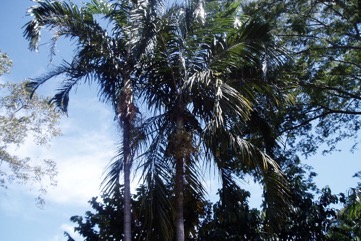
It is a tropical plant. They need a temperature above 13-15°C. It will grow on most soils. It needs a protected, warm, sunny position. It is damaged by drought and frost. It needs regular moisture and humidity. Plants are often on creek banks and low sites which are occasionally flooded. The soil needs to be well-drained. In the Cairns Botanical Gardens. It suits hardiness zones 11-12.
Also known as:
Jora, Palem carpentaria, Thora, Yigora, Yirrgi yirrgi
Synonyms
- Kentia acuminata H. Wendl. & Drude
Edible Portion
- Heart, Buds, Cabbage, Palm heart
Where does Carpentaria palm grow?
Found in: Asia, Australia, Indonesia, North America, SE Asia, United States
Notes: The juice from ripe fruit can damage skin. There is only one Carpentaria species.
Growing Carpentaria palm
Cultivation: Plants are grown from fresh seed. Seed germinate in 2-4 months. Seedlings are not easy to transplant. They should be re-potted regularly.
Edible Uses: The palm heart is edible but as this would kill the palm it is not normally eaten.
Production: They grow quickly in hot, humid places.
Nutrition Info
per 100g edible portion| Edible Part | Energy (kcal) | Protein (g) | Iron (mg) | Vitamin A (ug) | Vitamin c (mg) | Zinc (mg) | % Water |
|---|---|---|---|---|---|---|---|
| Palm heart | - | - | - | - | - | - |
Carpentaria palm Photos

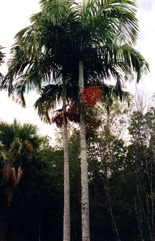
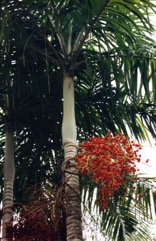
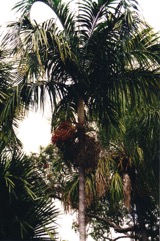
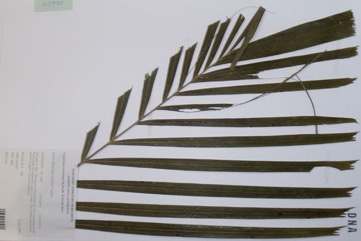
References
Ann. Jard. Bot. Buitenzorg 2:128. 1885
Blomberry, A. & Rodd, T., 1982, Palms. An informative practical guide. Angus & Robertson. p
Bodkin, F., 1991, Encyclopedia Botanica. Cornstalk publishing, p 216
Brickell, C. (Ed.), 1999, The Royal Horticultural Society A-Z Encyclopedia of Garden Plants. Convent Garden Books. p 231 (Photo) Brock, J., 1993, Native Plants of Northern Australia, Reed. p 115
Checklist of NT Vascular Plant Species. January 2003.
Cherikoff V. & Isaacs, J., The Bush Food Handbook. How to gather, grow, process and cook Australian Wild Foods. Ti Tree Press, Australia p 198
Cronin, L., 1989, The Concise Australian Flora. Reed. p 206 (Picture)
Cronin, L., 2000, Australian Palms, Ferns, Cycads and Pandans. Cronin Publications. p 18
Cundall, P., (ed.), 2004, Gardening Australia: flora: the gardener's bible. ABC Books. p 332
Elliot, W.R., & Jones, D.L., 1982, Encyclopedia of Australian Plants suitable for cultivation. Vol 2. Lothian. p 465
Gibbons, M., 2003, A pocket guide to Palms. Chartwell Books. p 64
Hearne, D.A., & Rance, S.J., 1975, Trees for Darwin and Northern Australia. AGPS, Canberra p 39, Pl 11
Jones D, L, 1986, Ornamental Rainforest Plants in Australia, Reed Books, p 327
Jones, D.L., 1994, Palms throughout the World. Smithtonian Institution, Washington. p 57, 161
Jones, D.L., 2000, Palms of Australia 3rd edition. Reed/New Holland. p 82
Lazarides, M. & Hince, B., 1993, Handbook of Economic Plants of Australia, CSIRO. p 49
Llamas, K.A., 2003, Tropical Flowering Plants. Timber Press. p 97
Morley, B.D., & Toelken, H.R., (Eds), 1983, Flowering Plants in Australia. Rigby. p 394
Nicholson, N & H., 2000, Australian Rainforest Plants, V. Terania Rainforest Publishing. NSW. p 16
Riffle, R.L. & Craft, P., 2003, An Encyclopedia of Cultivated Palms. Timber Press. p 288
Sukarya, D. G., (Ed.) 2013, 3,500 Plant Species of the Botanic Gardens of Indonesia. LIPI p 766
Tiwi Plants and Animals. 2001, Aboriginal flora and fauna knowledge from Bathurst and Melville Islands, northern Australia. Northern Territory Botanical Bulletin; No. 24 p 35
Townsend, K., 1994, Across the Top. Gardening with Australian Plants in the tropics. Society for Growing Australian Plants, Townsville Branch Inc. p 123
Wightman, G. M. & Andrews, M.R., 1989, Plants of Northern Territory Monsoon Vine Forests (Vol 1). Conservation Commission of Northern Territory. p 142
Yunupinu Banjgul, Laklak Yunupinu-Marika, et al. 1995, Rirratjinu Ethnobotany: Aboriginal Plant Use from Yirrkala, Arnhem Land, Australia. Northern Territory Botanical Bulletin No 21. Parks and Wildlife Commission of the Northern Territory. p 26